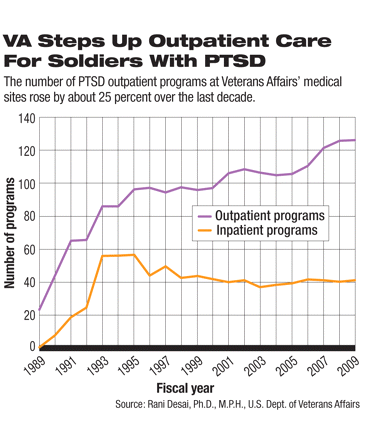American fighting men and women would benefit from comprehensive approaches for recognizing and treating posttraumatic stress disorder (PTSD) once they return from active war zones, PTSD experts told panelists at the Institute of Medicine in April in Washington, D.C.
The meeting was part of an ongoing assessment of treatments for PTSD requested by the Department of Defense and Department of Veterans Affairs (VA).
"There should be no wrong door to which veterans or their families can come for help," said Harold Kudler, M.D., associate director of the VA's Mental Illness Research, Education, and Clinical Center in Durham, N.C., and an associate clinical professor of psychiatry at Duke University Medical Center.
Other speakers discussed ways of opening those doors for current and former service members.
One logical place for active-duty troops to begin and continue treatment for PTSD is the primary care clinic on their base, said U.S. Army Col. Charles Engel, M.C., a psychiatrist who is director of the Deployment Health Clinical Center. Army soldiers visit those clinics an average of 3.4 times a year, and 90 percent are seen there at least once.
Primary care is thus a logical place to introduce screening and care for PTSD and depression, said Engel. Soldiers would be "getting care where they want it."
To provide screening and care, the Army developed a variation of the MacArthur Foundation depression model of care. The program uses three components: a specially trained primary care practice team, including a physician; a care manager, usually a nurse; and a behavioral health care specialist, typically a psychiatrist, who serves as a consultant.
The MacArthur model, called RESPECT (Re-Engineering Systems of Primary Care Treatment) was modified by Engel and his colleagues to include PTSD as well as depression and labeled RESPECT-MIL.
"The goal is to follow patients and keep them in care," said Engel. "It reduces stigma and barriers to access, reduces unnecessary service use by intervening earlier, and addresses needs now being unmet."
RESPECT-MIL is in use at 61 of 95 Army primary care clinics around the world and is being expanded to the rest.
Clinicians in the RESPECT-MIL program elicit patients' preferences for treatment and then offer several options, including medications and psychosocial interventions. The care manager follows up with outreach and monitoring. The consulting psychiatrist meets once a week with the care manager to make treatment adjustments and identify nonresponders.
Since the program began, more than 800,000 soldiers have been screened, with 13 percent screening positive for PTSD or depression. Referrals for care are up, but Engel said that only 20 percent of those who begin care make more than four visits, mainly because training or deployment schedules interfere.
"However, the biggest problem in introducing RESPECT-MIL is getting clinic staff to find the time for the 2.5 hour training and then adding another element to their daily routine," Engel told the IOM panel. "But eventually they find the program acceptable and feasible, and the soldiers enrolled show clinical improvement."
Engel and his colleagues are working to cut the initial training session down to an hour and a half.
Substantial Proportion Fail to Get Care
Mandatory surveys indicate that once back from Iraq or Afghanistan, troops often need care for mental health problems, said Kudler.
"Overall, 20.3 percent of the active-component troops and 42.4 percent of Guard and Reserve troops were identified as needing mental health care," said Kudler. "Not all soldiers or veterans will develop a mental illness, but they and their families will all face important readjustment issues."
Regular, "active-component" troops can get care and support on their bases, but once they leave the service, they may need help from the VA or from community sources.
The VA's role in treating PTSD began in 1987, with mixed clinical results, explained epidemiologist Rani Desai, Ph.D., M.P.H., acting director of the VA's Northeast Program Evaluation Center in New Haven, Conn.
Today, only about one-third of veterans diagnosed with PTSD are seen in a specialty program; the rest are treated in general mental health settings, she said. The number of outpatient PTSD programs within the VA has risen from 50 in 1990 to 124 today, while the number of inpatient programs has remained at about 40.
Desai noted that the most common questions from Congress, the public, and the media about treatment of PTSD in the VA system have to do with numbers: How many veterans develop PTSD? How many are treated in the VA? How many receive specialized care?
"We almost never get asked: Do they get better?" she stated.
To get an answer, the VA will improve its electronic data collection this year to evaluate program-level data on psychotherapy, medication use, and use of other medical services. In turn, such data should help the IOM clarify which treatments work best for PTSD.
The VA is also moving toward a standardized, consistent definition of "a patient with PTSD," a deceptively simple question that may have more than one answer, she noted.
For instance, if the definition is "any visit or bed day with the diagnosis," there were 494,202 PTSD patients in 2009. However, if the definition is "two visits or bed days with diagnosis primary and one mental health visit," the number was 312,252.
Vet Centers Are Crucial Component
Formal VA medical settings are not the only ones in which veterans can get help.
Since the end of the Vietnam War, one of the most open doors for combat veterans has been the VA's Readjustment Counseling Services, better known as Vet Centers, deliberately located at sites away from established VA medical facilities.
"Our mission is the successful postwar adjustment of veterans in or near their communities," said chief readjustment counseling officer Alfonso Batres, Ph.D., the head of the program. "The goal is to eliminate barriers to care. There's no copay and no waiting list. About 40 percent of our clients are not seen elsewhere in the VA system."
Vet Centers were created in the 1970s for Vietnam veterans as an alternative to the VA, but they now offer counseling services themselves and serve as a portal into the larger VA system, Batres told the IOM panel.
His 1,900 staff members (most of them combat veterans) take a thorough history from each new entrant, covering life before, during, and after military service. They use the standard four-item VA PTSD screen and can provide treatment at the Vet Center or work to get the veteran into appropriate care at the nearest VA medical center or clinic.
Not All Veterans Have Same Needs
One group of troops requires special attention to its postwar needs, said Kudler.
Of the 2.2 million U.S. troops who have served in Iraq or Afghanistan, 602,000 are reservists or members of the National Guard. They perform the same duties as regular troops in the war zones, but face different circumstances upon their return home.
Active-component personnel deploy with their units, live on or near military bases, get their care at military health facilities, and come home to families deeply involved in a military culture.
In contrast, reserve component troops (including National Guard personnel) often deploy as individuals, returning without the day-to-day support of their comrades in arms. They may also face a rapid transition back into civilian life and face more readjustment problems than active-component troops who return to a military base. They live in their home communities and get health care in those communities, and their families may not identify themselves as military families.
As a result, Reserve and National Guard members may find little support or continuity when they get home and may be far from VA medical facilities.
Reaching them means taking a public-health approach, "not just catching guys with PTSD," said Kudler.
Such an approach would involve efforts not only by the Department of Defense and the VA, but also at the state and community levels to enhance access to and quality of services for veterans and reserve component members and their families, Kudler suggested (see
To Be Effective, PTSD Education Must Focus on ‘Real Soldiers’).
He described for the panel a system begun in 2006 in North Carolina to connect returning soldiers to state services for veterans. The initiative, the North Carolina National Guard Integrated Behavioral Health System, ties into other state programs, including the state's National Guard Family Assistance Centers, each of which employs a behavioral health specialist.
This is just the start at building resilience among combat veterans and their families, said Kudler. The usual clinic-based systems aren't enough. "We have to strengthen family and community systems because they are some of the best resilience factors we have," he said. "Helping veterans stay in school or on the job once they return home is just as important as medical treatment."
The IOM panel plans to continue its investigation into PTSD treatment for several more years.

